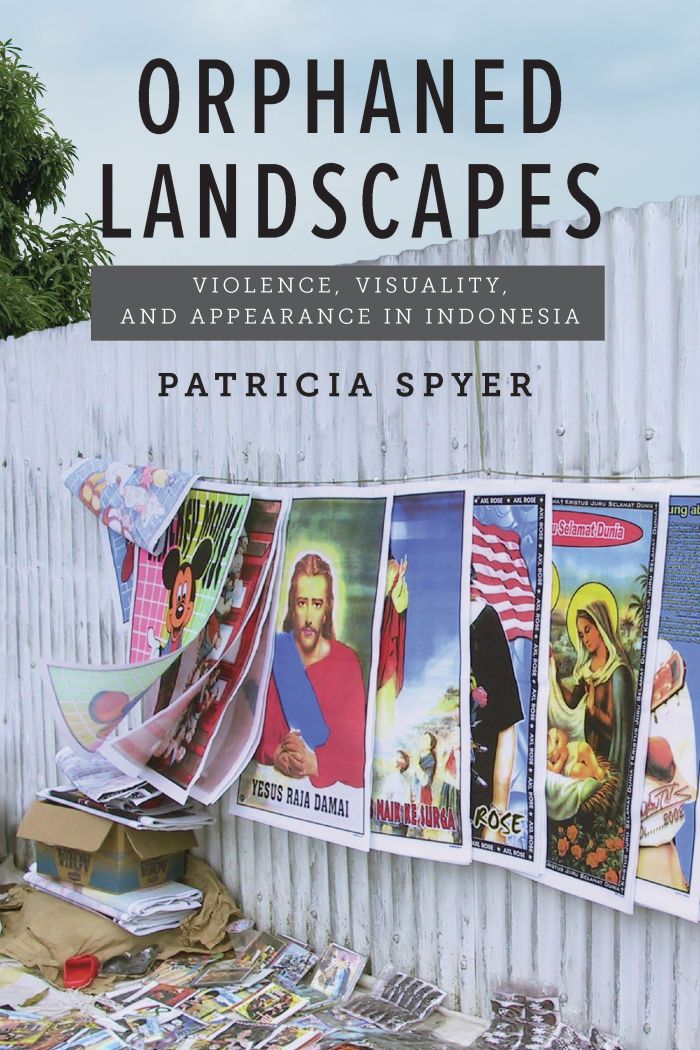Orphaned Landscapes
Violence, Visuality, and Appearance in Indonesia

This book can be opened with

Less than a year after the end of authoritarian rule in 1998, huge images of Jesus Christ and other Christian scenes proliferated on walls and billboards around a provincial town in eastern Indonesia where conflict had arisen between Muslims and Christians. A manifestation of the extreme perception that emerged amid uncertainty and the challenge to seeing brought on by urban warfare, the street paintings erected by Protestant motorbike-taxi drivers signaled a radical departure from the aniconic tradition of the old colonial church, a desire to be seen and recognized by political authorities from Jakarta to the UN and European Union, an aim to reinstate the Christian look of a city in the face of the country’s widespread islamicization, and an opening to a more intimate relationship to the divine through the bringing-into-vision of the Christian god.
Stridently assertive, these affectively charged mediations of religion, masculinity, Christian privilege and subjectivity are among the myriad ephemera of war, from rumors, graffiti, incendiary pamphlets, and Video CDs, to Peace Provocateur text-messages and children’s reconciliation drawings. Orphaned Landscapes theorizes the production of monumental street art and other visual media as part of a wider work on appearance in which ordinary people, wittingly or unwittingly, refigure the aesthetic forms and sensory environment of their urban surroundings. The book offers a rich, nuanced account of a place in crisis, while also showing how the work on appearance, far from epiphenomenal, is inherent to sociopolitical change. Whether considering the emergence and disappearance of street art or the atmospherics and fog of war, Spyer demonstrates the importance of an attunement to elusive, ephemeral phenomena for their palpable and varying effects in the world.
Orphaned Landscapes: Violence, Visuality, and Appearance in Indonesia is available from the publisher on an open-access basis.
In this profound book, Patricia Spyer brings us into the streets and homes of a city emerging from a civil war that severed bonds of community, destabilized the very ground of living, and rendered familiar social terrain uncertain and obscure. With uncommon ethnographic sensitivity, Spyer attends to the “figural impulse” that motivated people to make and display images as moorings to orient a newly disfigured world. Illuminating the work of and on appearances, Orphaned Landscapes will be richly rewarding for anyone interested in the aftermaths of violence and the potency of images.—Karen Strassler, Queens College and The Graduate Center, CUNY
A work of great subtlety and insight, Orphaned Landscapes charts the desperate operations of the image to hold together a world spiraling toward chaos and religious violence. As Ambon’s longstanding religious and political order disintegrated following the collapse of the Suharto regime in 1998, the visual became intensely charged with political and epistemic demands, giving rise both to an explosion of religious imagery across public spaces and to new practices of perception by which Christian and Muslim communities sought to navigate a precarious and threatening political terrain. Spyer’s superb analysis of the conditions of blindness and visibility that produce and accompany the fog of war is an immense intellectual accomplishment.—Charles Hirschkind, University of California, Berkeley
Patricia Spyer’s Orphaned Landscapes is both a revealing meditation on violence and a deep exploration of what she calls “the work of and on appearances”. . . Her writing is richly evocative and densely layered, and the 119 color plates in the book convey both the ubiquity and the arresting power of the images that are its subject. If the effects of images remain elusive and resistant to our clunky social scientific lenses, this immersive, moving book helps us to grasp how profoundly they shape us and our worlds.—American Ethnologist
Orphaned Landscapes is an important study of the topics of violence, religion, and visual discourse that deserves our attention.—Politics, Religion & Ideology
...the audience for this accessible work will include those who are not Indonesia specialists and those interested in intersections between street art, religion, and conflict.—Choice Reviews
Introduction: Violence, Visuality, and Appearance | 1
Image, Appearance, Figuration, 8 • A Christian
Town, 11 • The Appearance of Crisis, 15 • Matters
of Perception, 18 • Orphaning the Nation, 20 •
Orphaned Landscapes, 23 • A Symptomatology
of Crisis, 28
1 Fire without Smoke | 33
War’s Fog, 36 • Fire without Smoke, 40 • The Thick
of Things, 45 • Soundtracks of War, 52 • Amplifications, 54 •
Anticipatory Practices, 58 • Official Peace, 63
2 Christ at Large | 67
Christ at Large, 76 • The Canon in the Street, 79 •
Guardians of the Neighborhood, 88 • Streetwise
Masculinity, 96 • This Face Wants you, 104 • Sighting
the Street, 109
3 Images without Borders | 113
Painting Christianity, 116 • Landscape I: Christian Enclave,
127 • Landscape II: Pancasila Jesus, 132 • Landscape III:
Sidewalk Citizenship, 136 • Landscape IV: Witnessing
the End-Time, 146 • Frames at War, 152 • A Frenzy
of the Visible, 154
4 Religion under the Sign of Crisis | 157
Times Rich in Demons, 158 • Conversion’s Unstable
Alchemy, 161 • Religion under the Sign of Crisis, 163 •
Simplifications, 166 • Terms of Coexistence, 170 •
Symptomatology: Treacherous Things, 176 • Symptomatology:
Treacherous Persons, 180 • Neighbors and Neighborhoods, 184
5 Provoking Peace | 191
Spectacles of Reconciliation, 193 • The Child in the Picture,
199 • Peace Journalism, 214 • Scrolling for Peace, 222
Conclusion: Ephemeral Mediations | 229
Acknowledgments | 233
Notes | 239
Works Cited | 281
Index | 299



